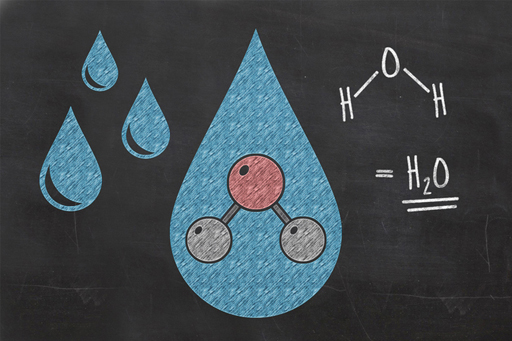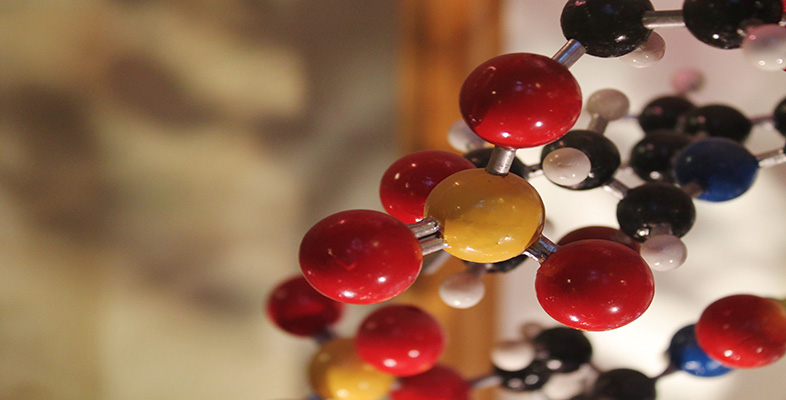1.9 Small things, small numbers

You’ve seen how we can use numbers to describe large things, like the world’s oceans, but what about small things? The same issue arises: how do you visualise something you can’t see? This is particularly important for science since all the matter that makes up the world around you is made of extremely small units, atoms that you’ll never see.
Small things
Atoms come in many different elements: oxygen, hydrogen, carbon, gold, uranium, etc. An individual atom is far too small to be seen with an ordinary microscope, but if you get enough atoms in one place, you will have something you can see. For example, there are around 100,000,000,000,000,000,000 (1020) atoms in a grain of sand.
We can see objects smaller than a grain of sand or a drop of water, a human hair, for example, is about a tenth of a millimetre across, or one ten-thousandth of a metre, or in scientific notation, 10-4 m (we missed off the ‘1 ×’ at the beginning of this which is a common and quick way of writing it and is a part of normal science communication). Depending on how thick the hair is, it might be 300,000 to 1,000,000 atoms from one side to the other. This is also about the limit of what the human eye can see, any smaller and we will need a microscope.
Small numbers: microns
The cells in your blood, which carry oxygen from your lungs to all the other cells in your body, are smaller than a human hair, they are around 7 × 10-6 m, or 0.000007 m across, otherwise referred to as 7 micrometres, or ‘microns’ (millionths of a metre). Micro is the scientific abbreviation for 10-6 or a millionth. Now we’re getting close to the world on the scale of bacteria. Bacteria come in a range of sizes but are typically between half a micron and several microns long. An individual bacterium might be made of several hundred trillions of atoms. A trillion is 1,000,000,000,000 or 1012.
At a factor of 10 smaller than bacteria, we enter the world of the virus. These non-living infectious agents, such as HIV or hepatitis B, are typically 10-7 m, or 0.0000001 m, or 0.1 microns across and are at the very limits of optical microscopes which depend on visible light wavelengths around 0.4 to 0.7 microns.
Nanometers
Deoxyribonucleic acid or DNA, the famous ‘double helix’, which holds the genetic instructions for building an organism is about a hundred times smaller than a virus, it has a width of 3 × 10-9 m, or 3 nanometres. You might imagine that there is not much smaller than this, but a single strand of DNA still contains a couple of hundred billion atoms.
At 10-9 m, or 0.000000001 m across we enter the ‘nano’ world. This world is the world of atomic engineering; building carbon nanotubes and engineering structures by moving individual atoms around, with applications in medicine, cosmetics, food packaging, disinfectants, textiles, and as fuel catalysts. Biotechnology is at the cutting edge of several new industries and is likely to be a growth industry in the coming decades, although it is also controversial because, as you can probably imagine, nano particles are much smaller than, and have the capability to pass through, cells such as blood cells. The water molecule mentioned earlier is about 2.8 x 10-10 m or 0.28 nanometres across. You can see now how easy it is to fit 1020 molecules of H2O into a single tiny drop.
Subatomic particles
As we go even smaller, we pass the limits of all kinds of microscopes and enter the subatomic world. At about 10-14 m, we are at the scale of the atomic nucleus. This is 0.00000000000001 of a metre across. Another ten times smaller and we are at the scale of the protons and neutrons that make up an atomic nucleus.
Another ten times smaller, at scales of 0.0000000000000001 of a metre, or 10-16 m, our understanding of the universe gets a little uncertain and the sizes are just estimates. For example, scientists think the weak nuclear force, which is responsible for the decay of radioactive particles, operates on scales of 10-17 m, or 0.00000000000000001 m. The quarks that are thought to make up protons and neutrons are thought to be on the scale of 10-18 m, or 0.000000000000000001 m.
One of the most common subatomic particles in the universe is the neutrino. It is thought to have a size of about 10-24 m, or 0.000000000000000000000001 m. Neutrinos are produced in the nuclear reactions that make stars, like our Sun, shine. Billions of them pass through you every second, but they very rarely interact with other types of matter, so you never notice them. Scientists have constructed very large neutrino detectors underground to try to learn more about these odd particles.
It’s difficult to conceive of an object smaller than a neutrino, but the smallest measurable length is called the Planck length (which is 1.616 × 10-35 m or 0.00000000000000000000000000000000001616 m). Due to various universal limits, it is impossible to measure anything smaller than this. This may seem a little weird, but the universe is weird at these scales.
